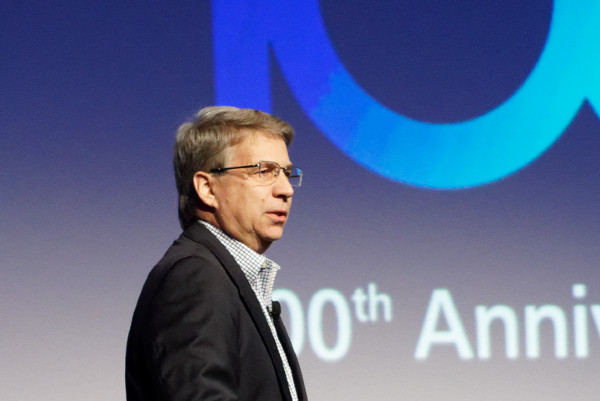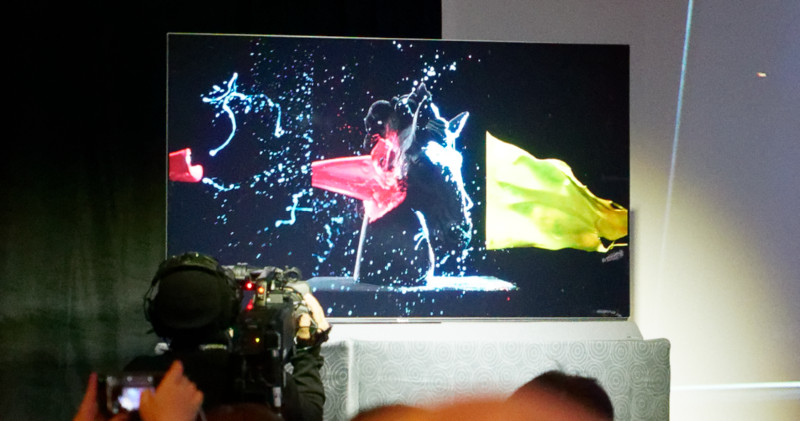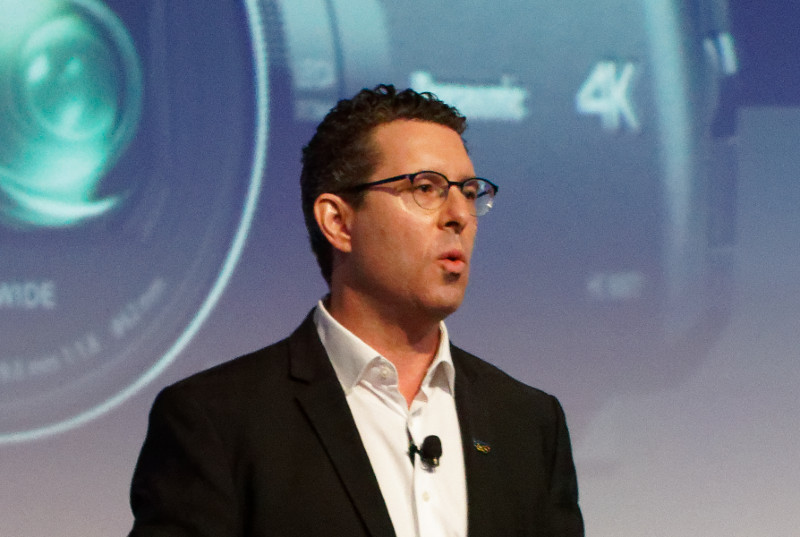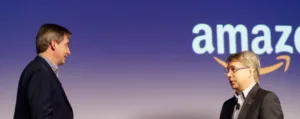Panasonic had a press event on the main press day and started by pointing out that the company is now 100 years old. It has always been in the consumer business, but is increasingly in solutions and B2B and system solutions.
Lauren Sallata is CMO for Panasonic Corp in North America (PCNA) and she said that analysts have identified 12 disruptive technologies for the next few years and Panasonic is in nine of those, so it is well set for the future.
Tom Gebhardt is Chairman and CEO of PCNA and he announced a new digital solution centre that will be in the company’s solutions group. There will be ‘several hundred’ engineers and which will develop solutions in retail, theme parks etc, where the focus is bringing physical and digital system together. The company has already had some success in the automotive and aviation markets. Gartner said 2018 is a key year for the integration of physical and digital systems.
 Panasonic’s Gebhardt did most of the talking. Image:Meko
Panasonic’s Gebhardt did most of the talking. Image:Meko
Connectivity is increasingly a requirement and Gebhardt said that in aviation, satellite Wi-fi is now getting to the third generation and Panasonic has a new satellite modem that offers a 20x improvement in broadband bandwidth into planes, which may possibly even allow video streaming in aircraft. Installations will start in in Q1 with a couple of US airlines.
Panasonic has a concept ‘Vehicle of the future’. Automotive is a major opportunity for Panasonic for the future – it claims to be the largest maker of automotive infotainment systems globally, but in the future the market will need new platforms to transform passenger and driver experiences. Panasonc is working with Amazon and Tom Taylor Senior VP, Amazon Alexa, came on to join the conference.
Panasonic brought Tom Taylor of Amazon Alexa on – Image:Meko
Voice is becoming better and more important, but you want Alexa with you everywhere, Taylor said, for example if you are listening to an audible book, you may want to go from home and continue in the car. Alexa has added a voice profile function to recognise who is speaking so that you can ask Alexa to “play my music”. Taylor then showed a video about how Alexa would work in cars. Examples included voice access to weather information or navigation, you could ask “how far is the convention centre from here?”. Alexa can help you to find an electrical charging station. If the system is offline there is less information, but Alexa would still work supplying information, for example, on calendar events.
Alexa is integrated into Panasonic’s Skip Gen In Vehicle Infotainment platform, which was announced at last year’s show, and Panasonic is one of the first with Alexa onboard.
Last year at CES there was a lot of talk of intelligent highways and the first project has now been announced after the Colorado transport committee visited the show. First approval is a section of 90 miles and Panasonic believes that the capacity of the highway will be increased by 4X, with up to 80% fewer crashes.
Panasonic said that your car can become a living room or a place celebration once you are autonomous. (But see our report on Faurecia for an interesting perspective on this – Man. Ed.)
Panasonic claims to be the #1 in batteriles for EV vehicles and the company believes that elctrification is inevitable. The firm estimates that by 2020 cost of power train will be the same for electric and conventional vehicles and from then, there will be exponential growth. The company is building a new battery factory with Tesla and is also now working with Toyota on EV batteries. These will be based on Lithium Ion technology and the firm is developing new “Solid State” batteries.
The company is still working with Tesla to develop solar for the home. 1 billion people live off the grid and solar lanterns can be a game changer and Panasonic committed to give away 100,000 lanterns some time ago and has now done that.
Integrated Supply Chain
Panasonic has been working with retailers and restaurant outlets on system solutions. Consumers start with digital shopping, then go physical. There is an interesting development with Ford – a key drop off system to make auto service more convenient (see More Kiosks Appear in Automotive and QSR Applications). Restaurants are digitising and there are systems now that automatically detect consumers within 5 minutes of a location to allow staff to pre-prepare drinks or food from an early order.
The Solutions group is working with Zetes of Belgium (which the firm acquired in the summer of 2017 – Man. Ed.) on a complete packaging to store process to make the supply chain more efficient.
Robotics
Robots are built that are getting better at copying human movements and there are a lot of uses, for example in retail using RFID. Robots can be used for adding strength to human operators and robots can help with food harvesting, even being able to handle delicate crops such as tomatoes.
Immersive Entertainment
The company is involved with lots of sports event and locations including the US Olympic Museum in Colorado Springs where it has created a ‘transformational visitor experience’ and where it also has a Smart City plan. Smart Cities are important and a new development is a streetlight that can detect the depth of snow on the street and report this back to planners and authorities. The Mayor of Colorado Springs was in the audience at the event.
Panasonic is Still in TV & Audio
Panasonic is still in the TV market, but not in the US, so it made some comments about ‘global’ TV. Michael Moskowitz, President of Panasonic CE in North America, said that the company started in the market with 17″ mono CRT TVs in 1951 and is now dedicated to ‘bringing Hollywood to the Home’ – CES 2018 was the FZ950 and FZ800 Series global launch event. Panasonic OLED TV sets are being used as client reference monitors in Hollywood production houses, including C03, EFilm, Encore and Deluxe. Deluxe and others are collaborating with the company to further refine and develop image quality. The new sets have an upgraded HCX ‘Hollywood tuned’ processor and ‘Tuned by Technics’ audio. The UltraHD 2018 OLED models will now support the HDR10+ technology.
 Panasonic used the event as a global launch for new OLED TVs. Image:Meko
Panasonic used the event as a global launch for new OLED TVs. Image:Meko
There are new UltraHD Blu-ray players, the UB420 and UB820 that will also support HDR10+ and more streaming services.
Entertainment in the home is rapidly evolving and the firm is working with Amazon and Google. Voice assistant products are typically short on audio quality, it believes, so it has developed the GA10 smart speaker with Google Assistant and which is intended to have high audio quality. It is looking to integrate into other platforms such as home monitoring systems and it has developed the HomeHawk HD home security camera. This is designed that it can work with no cloud services for those that are concerned about security and privacy issues.
Gen Z and Y are often looking to the past for new experiences. Vinyl is still popular and the company has new SP-10R and SL1000R turntables. The SP10 was the first direct drive turntable from Techniks in 1970 and became the industry standard. Now the SP-10R will be the ‘most advanced turntable ever’ (and we heard later that as a result will cost around $10K, with the SL1000R at $20K!)
Video and photography remain big target consumer markets and at the show were new WXF1, HC-VXF1 and HC-VX1 camcorders which have new body design and lenses up to 32x zoom as well as improved low light performance. (the company also has a new HC-V800 FullHD camcorder)
The Lumix GH5S is a new version with better video developed after the company listened to the feedback from film makers. It has the best ever low light sensitivity for Lumix and has new dual ISO technology to reduce noise for low light and it also has HLG and 10 bit log recording. It is claimed as the only mirrorless 60fps 4K camera in the market (Sony’s A7SII only supports 30fps – Man. Ed.)
HomeX is the firm’s brand for intelligent appliances in the home. There was a “Vision 2035” concept being shown on the booth.
 Panasonic’s Moskowitz covered the CE categories. Image:Meko
Panasonic’s Moskowitz covered the CE categories. Image:Meko
Gebhardt then came back and said that the firm is developing 140 products with Google and he introduced Gene Karshenboym from Google. Android is getting onto auto platforms – the speed of development is increasing and the Android O system is running on the Skip Gen architecture.
Google has been adding functions for auto use for some time and that is accelerating. There are new services including “best in class” GPS including a new Google Maps app that works on the Skip Gen platform. You can select music or other services and as an example, the audio can advise of traffic problems. A demo was shown of setting the heating in the car and locking it and turning off home lights.
Google is integrating Google Assistant to the vehicle which needs to work well both online and offline. The market will start to see the Skip Gen architecture in autos ‘soon’.

